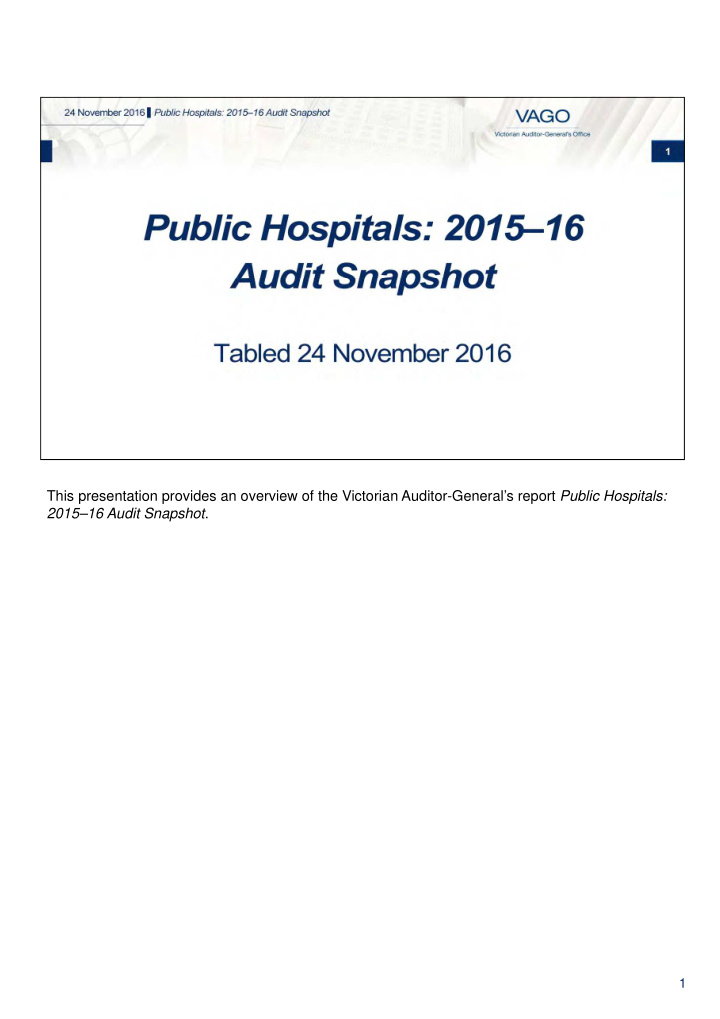



This presentation provides an overview of the Victorian Auditor-General’s report Public Hospitals: 2015–16 Audit Snapshot . 1
Victoria’s public hospital sector is made up of 87 public hospitals and 22 controlled entities. Public hospitals are primarily funded by the state and Commonwealth governments, and funding amounts vary, depending on the type of patients that hospitals treat and the services they provide. We have classified the 87 public hospitals into four groups—metropolitan, regional, rural and small rural—based on the location, size and the funding they receive. 2
In this report, we commented on the matters arising from the 2015–16 financial report audits of the 87 public hospitals in the public hospital sector. We also assess the sector’s financial performance during 2015–16 and its sustainability risks as at 30 June 2016, and we comment on capital funding in the sector through some case studies. 3
All of these hospitals and entities received clear audit opinions on their financial reports for the financial year ended 30 June 2016. Parliament and the Victorian community can have confidence in these reports. We reviewed the relevant internal control frameworks of each public hospital, and found 236 control weaknesses and financial reporting matters, half of which were rated as medium or high risk. Public hospitals have acted to remediate matters raised in previous audits, and they resolved 70 per cent of these matters in 2015–16. However, some high-risk and medium-risk problems remain. 4
The public hospital sector overall had a net deficit of $115.9 million in 2015–16, which was an improvement of $19.9 million from last year. Increases in capital funding and revenue from private patients and residents drove this improvement. The sector also controls $16.5 billion in assets, an increase of $1.6 billion from last year. This increase was largely from the commissioning of the Victorian Comprehensive Cancer Centre, which houses the new Peter MacCallum Cancer Centre at $1.3 billion. 5
To be financially sustainable, hospitals need to be able to fund their current and future costs. They also need to be able to absorb the financial effects of economic changes and financial risks, without significantly changing their revenue and expenditure policies. Overall we assessed the public hospital sector as having a medium risk to financial sustainability for the year ended 30 June 2016. This is consistent with our assessments in the previous five years. 6
We based our financial sustainability assessments on four risk assessment indicators—net result, liquidity, days cash available and capital replacement. Some hospitals continue to face short-term challenges to meet their financial obligations over the next 12 months. Capital replacement was rated as the most significant financial sustainability risk for the sector as a whole. 7
As shown in this graph, the challenge at some hospitals is the ability to generate a positive net result and to replace assets faster than they are being consumed. We found this challenge to be the greatest in rural and small rural hospitals, where the rate of depreciation outstrips the capital funding achieved. 8
In 2015–16, public hospitals received $901 million of capital and specific purpose income in the form of grants, donations and bequests, and capital contributions from the state and other parties. These funds are used by public hospitals to renew and upgrade existing assets, and acquire new assets. Overall, the public hospital sector appears to have adequate capital funding to cover depreciation. However, individual hospitals face challenges in generating sufficient income for capital works to keep pace with their consumption of assets. To address this, public hospitals continue to use short- to medium-term measures such as selling surplus assets or relying on donations as a means of funding. This is not sustainable in the long-term to address the shortfall between available capital funding and the sector’s asset replacement needs for individual hospitals. 9
We made one recommendation in this audit directed to public hospitals. Public hospitals need to promptly address matters raised in our most recent and previous audits and rectify any weaknesses in their internal control environments to mitigate the risk of material errors in their financial statements. We will continue to monitor the hospitals’ internal control environments during future audits. 10
For further information, please see the full report of this audit on our website, www.audit.vic.gov.au. 11
Recommend
More recommend